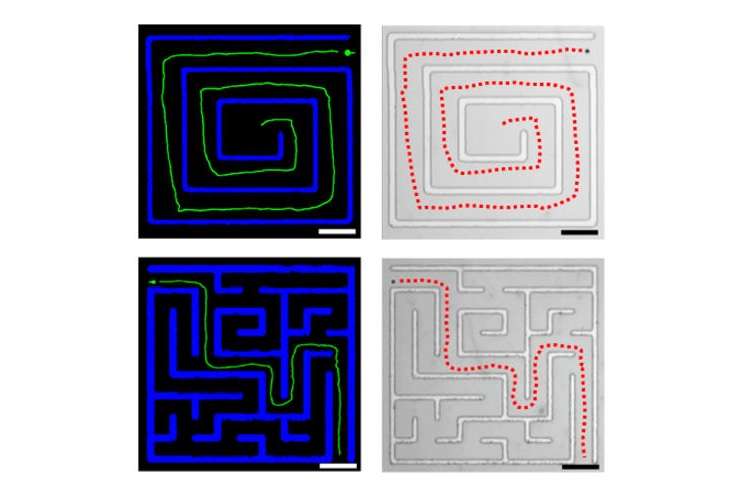August 28, 2017 feature
Self-driving vehicles at the microscale

(Phys.org)—In a new study, scientists have developed the microscale version of self-driving vehicles: a 5-μm spherical micromotor that autonomously navigates its way through micro-traffic along a micro-maze to reach its final destination. The researchers expect that these "smart microvehicles" have potential applications in biomedical tasks, such as delivering drugs to tumor cells while avoiding healthy cells.
The scientists, led by Longqiu Li at the Harbin Institute of Technology in China, and Joseph Wang at the University of California San Diego in the US, have published a paper on the smart microvehicles in a recent issue of ACS Nano.
"We have embedded artificial intelligence into a micro/nanorobot," Li told Phys.org. "We introduce a smart microvehicle for precise autonomous navigation in complicated and dynamically changing environments through optimal path planning. Similar to their large vehicle counterparts, the autonomous navigation of microvehicles entails collision-free movement in dynamic environments."
Until now, micro- and nanomachines have been restricted to navigation that uses a closed-loop control system, in which the machines can only move along a predefined path. The new study marks the first demonstration of micromachines that can autonomously navigate complex, dynamically changing environments, such as those with other moving micromachines.
The autonomous navigation process consists of three main steps. A CCD camera attached to a microscope takes pictures and sends them to a feature extraction processor, which identifies obstacles and constructs a map of the environment. The map is then sent as input to an Artificial Intelligence (AI) planner, which uses a path-searching algorithm and fuzzy logic approach to determine the shortest collision-free path among multiple possible paths to the destination. The AI planner then sends these travel directions to a magnetic field generator, which orients a magnetic field in such a way as to steer the microvehicle along the collision-free pathway.
The AI planner, which is at the heart of the smart navigation system, can also detect when the microvehicle drifts from its planned path, which can occur due to the presence of noise. In these cases, the AI planner can simultaneously measure the error and guide the microvehicle back onto the path.
One of the main applications of this type of smart microvehicle may be in the biomedical field for tasks such as disease diagnostics, drug delivery, and precision surgery. To demonstrate, the researchers showed that the microvehicle can use the camera to sense and distinguish between cancer cells, red blood cells, and mixed cells, by recognizing differences in their size and shape. The AI planner then regards the cancer cells as the targets and the other cells as the obstacles, and plans a path accordingly.
"We want to apply the micro/nanorobotic systems in the field of biomedical operations and nanoscale manipulation," Li said.
In the future, the scientists plan to develop more sophisticated autonomous microvehicles, with features such as autonomous braking, "cruise" control, lane-keeping, and the ability to interact with the environment.
More information: Tianlong Li et al. "Autonomous Collision-Free Navigation of Microvehicles in Complex and Dynamically Changing Environments." ACS Nano. DOI: 10.1021/acsnano.7b04525
Journal information: ACS Nano
© 2017 Phys.org


















